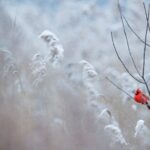Understanding Bird Anatomy for Identification
Learning to identify birds is a journey that starts with understanding bird anatomy. Bird anatomical features are detailed and can differ from species to species. However, certain features, such as the beak, feet, plumage, wing shape, and overall size, are crucial for distinguishing different species. For an in-depth exploration of bird anatomy, do check out this nature.com article.
As a birder, you’ll often find yourself noticing the size and shape of a bird’s beak, particularly useful for species that inhabit similar habitats but have diverse dietary habits. A sparrow, for example, has a short, thick beak for eating seeds, while a swift’s beak is short but wide for catching insects mid-flight. Feathers, or plumage, especially the variations in color and pattern, give us the most apparent bird identification cues. Pause for a moment and imagine a majestic Bald Eagle—its distinct white head and brown body are unmistakable even from a distance.
Common Birds in your Locale
Moving on to the birds themselves, the United States boasts a rich diversity of bird species. Ready for a virtual tour? Let’s identify some common birds in each region.
- Eastern Bluebird: These small and colorful birds are familiar sights in the east, with their bright blue feathers and rust-orange throats. They’re known to stay close to their nesting spots, often in forest edges or open farmland.
- American Robin: The state bird of Wisconsin, the American Robin is widespread through various habitats. Look for its gray-brown upper half and orange-red breast and belly. They are most active during the day.
- California Towhee: Found across California, this bird is of a brownish-grey color overall with rusty under-tail coverts. They have a unique scrubby habitat preference.
Using Bird Songs for Identification
Our journey doesn’t stop with sight alone—bird songs are equally critical for identification. Each bird has a unique vocalization, their symphony a mix of calls, songs, or even non-vocal sounds.
Take for instance the ‘Peter-Peter-Peter’ whistle of a Tufted Titmouse, or the melodious ‘drink-your-tea’ of the Eastern Towhee. Wouldn’t it be exciting to recognize a bird even with your back turned or eyes closed? Embrace the challenge and let the birds be your guide.
Tools for Bird Identification
The world of birding isn’t complete without the right tools. Binoculars are a birdwatcher’s best friend, magnifying far-off birds for your eyes to soak in the details. Invest in a good pair that is comfortable and easy to focus.
Power up your birding experience with bird identification apps. These let you identify birds by their pictures and songs, track your sightings, and learn more about bird habitats and behaviors. This tech synergy empowers a deeper connection with our avian friends.
Ethical Bird Watching
As birders, know and recognize our responsibility towards our feathered friends. We should maintain a respectful distance, never disturb nesting birds, and avoid using flash while photographing them. Here is an excellent resource on ethical wildlife observation practices from myfwc.com.
Looking into the world of birds, we step into the vast realm of feathers and song. An ethereal ballet of colors, voices, and the rhythmic flap of wings as they comb the skies. So, explore, experience, and cherish the birds around us, for they need us as much as we need them.



